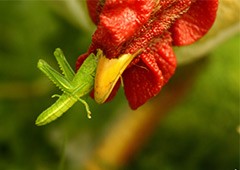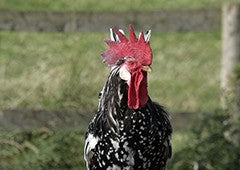Leeks may be slightly unfamiliar to some people in Australia. It’s hard to deny the fact that as far as vegetables go they are slightly bizarre - they look as though they are a cross between a carrot, onion and a cabbage. Those of us who still have a playful and childish side might not be able to resist the temptation to bludgeon our friends or partner in the supermarket with this notoriously firm and cylindrical vegetable. All oddities aside, leeks are a delicious and highly nutritious vegetable that can be an excellent addition to your family or flocks diet.
So, what is a leek?
Leeks, like garlic, belongs to the allium family, which also includes other household favourites, such as onions, shallots and scallions. It is believed that leeks were native to central Asia, but quickly spread throughout Europe and were relished by the Greek and Roman empires. The Emperor Nero allegedly ate leeks regularly as he believed it gave him a strong and resonant voice. They soon spread through what is now as the United Kingdom and was quickly adopted as the national emblem of Wales. All this history aside, leeks are essentially a firm cylindrical plant that is very similar to onions buts tends to have a more mild flavour.
Why should I eat leeks?
Similar to onions, leeks have a slightly sweet neutral flavour, which is a great addition to salads, soups and stocks. Leeks might not seem particularly compelling in terms of its flavour but that is no reason to banish it from your diet. There are numerous health benefits attached to eating leeks, all of which help to improve your immune system and overall well-being. Leeks are known to have many of the same health benefits as garlic, which essentially boils down to boosting the immune system and neutralising dangerous free radicals due to its inherent sulphur-compound content. Additionally, leeks contains kaempferol that is also found in the superfood kale, which ultimately helps lower the risk of cancer, as well as other chronic diseases.
Can I feed leeks to my chickens?
Backyard chickens will simply love munching diced up pieces of leek scraps! Its rich vitamin content will give your girls a healthy boost that may help them lay even more delicious and nutritious eggs. Another exciting side effect of feeding your chickens leeks is that its sulphuric content will help their bodies repel pests like lice, mites and worms. Garlic is a more potent source of these sulphur-compounds however serving leeks alongside a healthy diet of chicken feed, water, grit and other delicious scraps, may help protect your flock from these nasty pests.
When is the best time to grow leeks in Australia?
It takes approximately six months to grow leeks from seed to harvest, so it’s imperative that you sow your seed and transplant your seedlings at the correct time of year. It’s best to grow the seedlings throughout February and March or August and September, before transplanting the plants into the garden in either April to May or October through to December. Planting and transplanting at these times of year will help ensure that your leeks grow successfully. Attempting to grow leeks either in its seedling or transplanted phase at any other time of year may create problems due to the weather and climate. When it comes to growing leeks sometimes it pays to play by the rules.
How do I plant and grow leeks?
It’s important that you grow your leeks in healthy compost enriched soil to ensure that you get the best results. Adding chicken manure as fertiliser can help at various stages of the leeks 6 months growing process. So long as you have nutritious, moist and loose clay soils with a PH of around 6.5 your leeks should grow thick and firm without any trouble.
Seedlings
Many green thumbs prefer to forego growing their own seedlings from seeds, as leek seeds have a reputation of being difficult to source. There is no shame in buying pre-potted leek seedlings and transplanting them into your garden at home, however if you are determined to do this the good ole fashioned way here is what you need to do… Firstly, fill the seed tray with seed starting soil or standard potting mix, ensuring that you pack the mix down to remove any air pockets. Sow the seeds 3 cm apart from one another and cover with a thin layer of potting mix. Once seedling begin to appear after 10-14 days move to seed tray into a sunny spot, either near a window or onto the deck, ensuring that the temperature is around 18-23 degrees Celsius during the day. Simply water the seedlings when the surface of the potting mix feels dry. When your seedlings are approximately 15-20 cm tall it’s time to transplant them into your garden!
Transplanting
Transplanting leek seedlings into the garden is a little different compared to what you might do with some other vegetables. First things first, ensure that the soil temperature is between 8-30 degrees Celsius, which isn’t very hard to achieve if you are living in sunny Australia. Dig trenches or individual holes that are approximately 20-25 cm deep and 10 to 20 cm apart from one another. Empty the seedling out into the bottom of the trench or hole, ensuring that the roots are covered in a little damp soil so that they don’t dry out. Naturally, by way of rain, watering and irrigation, the holes will gradually fill in with soil, as the leeks grow, which is what we want to happen. Add plenty of mulch and compost as you go, to help keep the soil rich and nutritious.
Harvesting
There really isn’t much else to do other than your basic gardening chores, like watering the plants and attending to any pesky weeds. Leeks are hungry little plants so be sure to give them plenty of fertiliser as you go, as well as keeping the soil well watered. Once your leeks seem to be around 10 mm to 50 mm in diameter it’s time to pull them from the earth and store them in your kitchen! Simply keep them in your fridge for 1 to 2 weeks, unwashed and untrimmed.
How do you chop and prepare leeks?
Whether you’ve gone to the trouble of growing leeks yourself or if you’ve simply picked it up from a supermarket there may come a point when you set it down upon your chopping board and ask yourself the question, “How on Earth do I chop this up”? Chopping, slicing and dicing leeks is not nearly as painful and it’s close cousin onions, but it’s important to have a small idea of what you’re doing before you set upon the defenceless vegetable with a knife. Here’s a step by step guide…
- Rinse the leeks in cool water.
- Trim away any of the green parts.
- Chop off the roots.
- Slice the leeks in half, lengthways from the bottom to the top.
- Cut the leeks into thin half-moon shapes.
- Wash the leeks in a large bowl.
- Use your clean and chopped leeks to make anything from salads, soups and stocks.
There are of course many different ways to use leeks in your cooking including quiche, soup and stock recipes however due to its sweet, subtle and mild flavour, it is rarely the headlining attraction on your dinner plate. Nevertheless, it’s so beneficial to have leeks at the ready in your fridge or garden, as it’s an incredibly healthy addition to many different types of meals.
Did you know that chickens are a great companion animal to your garden? Chickens help nourish and enrich the soil through their droppings, as well as hunting pesky pests that plague your crops. If you’re an avid gardener be sure to check out our range of chicken tractors, like the Cluck House and Taj Mahal, which is the perfect way to keep a small flock of chickens in a suburban backyard. With chickens at your side your garden will be sprouting vegetables as diverse as leeks, garlic, cauliflower and chicory in no time.



















